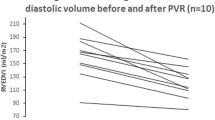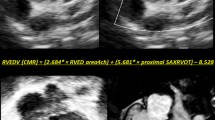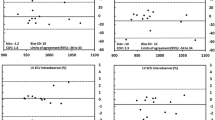Abstract
Aim
To evaluate changes of right ventricular (RV) parameters in follow-up examinations after corrected tetralogy of Fallot (TOF) by cardiac magnetic resonance (CMR).
Methods
CMR was performed twice within 4 years in 45 patients using a 1.5 T scanner. RV-volumes and pulmonary-regurgitant-fractions (PRF) were calculated from standard cine-sequences and flow-sensitive gradient-echo images, respectively. Patients were divided into two groups depending on the post-operative (po) interval (group 1 ≤5 years po; group 2 >5 years po) and subgroups depending on type of surgery (transannular vs. non-transannular). Patient groups were compared among each other and differences between 1st and 2nd CMR were assessed. Furthermore, patients were compared with 25 healthy volunteers.
Results
Compared with controls RV-size was increased (group 1: p = 0.007; group 2: p < 0.001) and RV function decreased (group 1: p = 0.02; group 2: p < 0.001) in po TOF-patients. PRF was higher in group 2 compared with group 1 (p = 0.04) and significant changes of PRF between 1st and 2nd CMR were found in group 2 (p < 0.01), but not in group 1 (p = 0.29). Compared with the non-transannular subgroup, PRF (p < 0.001) and RV end-diastolic-volume index (RV-EDVI) (p = 0.03) were significantly higher in patients with a transannular patch, EDVI increased between 1st and 2nd CMR. After correction, no significant changes of RV myocardial mass index (RV-MMI) were found.
Conclusion
After correction of TOF, RV-size, RV-muscle mass (RV-MM) was increased and ejection fraction decreased in “early” follow-up already. Whereas these parameters can remain stable over a long time period, the PRF significantly increased in “late” follow-up dependent on the po interval. Overall, transannular patching went along with higher PRF and bigger RV-size as well as a greater dynamic of these parameters in the time course, which makes this subgroup highly in need of regular follow-up examinations for the optimal timing of re-interventions. In contrast, the increased RV-MM demonstrated no regression po.





Similar content being viewed by others
References
Norgaard MA, Lauridsen P, Helvind M, Pettersson G (1999) Twenty to thirty-seven-year follow-up after repair for tetralogy of Fallot. Eur J Cardiothorac Surg 16(2):125–130
Nollert G, Fischlein T, Bouterwek S, Bohmer C, Dewald O, Kreuzer E, Welz A, Netz H, Klinner W, Reichart B (1997) Long-term results of total repair of tetralogy of Fallot in adulthood: 35 years follow-up in 104 patients corrected at the age of 18 or older. Thorac Cardiovasc Surg 45(4):178–181
Kerst G, Kaulitz R, Sieverding L, Apitz C, Ziemer G, Hofbeck M (2010) Restrictive ventricular septal defect and critical subaortic stenosis in tetralogy of Fallot. Clin Res Cardiol 99(4):247–249
Gatzoulis MA, Balaji S, Webber SA, Siu SC, Hokanson JS, Poile C, Rosenthal M, Nakazawa M, Moller JH, Gilette PC, Redington AN (2000) Risk factors for arrhythmia and sudden cardiac death late after repair of tetralogy of Fallot: a multi-centre study. Lancet 356(9234):975–981
Louie EK, Bieniarz T, Moore AM, Levitsky S (1990) Reduced atrial contribution to left ventricular filling in patients with severe tricuspid regurgitation after tricuspid valvulectomy: a Doppler echocardiographic study. J Am Coll Cardiol 16(7):1617–1624
Lin SS, Reynertson SI, Louie EK, Levitsky S (1994) Right ventricular volume overload results in depression of left ventricular ejection fraction. Implications for the surgical management of tricuspid valve disease. Circulation 90(5 Pt 2):II209–II213
Grothoff M, Spors B, Abdul-Khaliq H, Abd El Rahman MY, Aexi-Meskishvili V, Lange P, Felix R, Gutberlet M (2006) Pulmonary regurgitation is a powerful factor influencing QRS duration in patients after surgical repair of tetralogy of Fallot. A magnetic resonance imaging (MRI) study. Clin Res Cardiol 95(12):643–649
Davlouros PA, Kilner PJ, Hornung TS, Li W, Francis JM, Moon JC, Smith GC, Tat T, Pennell DJ, Gatzoulis MA (2002) Right ventricular function in adults with repaired tetralogy of Fallot assessed with cardiovascular magnetic resonance imaging: detrimental role of right ventricular outflow aneurysms or akinesia and adverse right-to-left ventricular interaction. J Am Coll Cardiol 40(11):2044–2052
Rebergen SA, Chin JG, Ottenkamp J, van der Wall EE, de Roos A (1993) Pulmonary regurgitation in the late post-operative follow-up of tetralogy of Fallot. Volumetric quantitation by nuclear magnetic resonance velocity mapping. Circulation 88(5 Pt 1):2257–2266
Grothoff M, Spors B, Abdul-Khaliq H, Gutberlet M (2008) Evaluation of post-operative pulmonary regurgitation after surgical repair of tetralogy of Fallot: comparison between Doppler echocardiography and MR velocity mapping. Pediatr Radiol 38(2):186–191
Debl K, Djavidani B, Buchner S, Poschenrieder F, Schmid FX, Kobuch R, Feuerbach S, Riegger G, Luchner A (2009) Dilatation of the ascending aorta in bicuspid aortic valve disease: a magnetic resonance imaging study. Clin Res Cardiol 98(2):114–120
Eitel I, Fuernau G, Walther C, Razek V, Kivelitz D, Schuler G, Thiele H (2008) Delayed enhancement magnetic resonance imaging in isolated noncompaction of ventricular myocardium. Clin Res Cardiol 97(4):277–279
Schroeder J, Peterschroeder A, Vaske B, Butz T, Barth P, Oldenburg O, Bitter T, Burchert W, Horstkotte D, Langer C (2009) Cardiac volumetry in patients with heart failure and reduced ejection fraction: a comparative study correlating multi-slice computed tomography and magnetic resonance tomography. Reasons for intermodal disagreement. Clin Res Cardiol 98(11):739–747
Loukanov T, Sebening C, Springer W, Khalil M, Ulmer HE, Hagl M, Gorenflo M (2008) Replacement of valved right ventricular to pulmonary artery conduits: an observational study with focus on right ventricular geometry. Clin Res Cardiol 97(23):169–175
Gutberlet M, Boeckel T, Hosten N, Vogel M, Kuhne T, Oellinger H, Ehrenstein T, Venz S, Hetzer R, Bein G, Felix R (2000) Arterial switch procedure for D-transposition of the great arteries: quantitative evaluation of hemodynamic changes with cine MR imaging and phase-shift velocity mapping-initial experience. Radiology 214(2):467–475
Vogel M, Gutberlet M, Dittrich S, Hosten N, Lange PE (1997) Comparison of transthoracic three-dimensional echocardiography with magnetic resonance imaging in the assessment of right ventricular volume and mass. Heart 78(2):127–130
Beerbaum P, Barth P, Kropf S, Sarikouch S, Kelter-Kloepping A, Franke D, Gutberlet M, Kuehne T (2009) Cardiac function by MRI in congenital heart disease: impact of consensus training on interinstitutional variance. J Magn Reson Imaging 30(5):956–966
van Straten A, Vliegen HW, Lamb HJ, Roes SD, van der Wall EE, Hazekamp MG, de Roos A (2005) Time course of diastolic and systolic function improvement after pulmonary valve replacement in adult patients with tetralogy of Fallot. J Am Coll Cardiol 46(8):1559–1564
Knauth AL, Gauvreau K, Powell AJ, Landzberg MJ, Walsh EP, Lock JE, del Nido PJ, Geva T (2008) Ventricular size and function assessed by cardiac MRI predict major adverse clinical outcomes late after tetralogy of Fallot repair. Heart 94(2):211–216
Pattynama PM, Lamb HJ, van der Velde EA, van der Wall EE, de Roos A (1993) Left ventricular measurements with cine and spin-echo MR imaging: a study of reproducibility with variance component analysis. Radiology 187(1):261–268
Pattynama PM, Lamb HJ, van der Velde EA, van der Geest RJ, van der Wall EE, de Roos A (1995) Reproducibility of MRI-derived measurements of right ventricular volumes and myocardial mass. Magn Reson Imaging 13(1):53–63
Gutberlet M, Abdul-Khaliq H, Grothoff M, Schröter J, Schmitt B, Röttgen R, Lange P, Vogel M, Felix R (2003) Vergleich der transthorakalen 3-D echokardiographie mit der mrt zur bestimmung linksventrikulärer volumina bei patienten mit pathologischer ventrikelgeometrie aufgrund angeborener herzfehler. Fortschr Röntgenstr 175(7):942–951
Lotz J, Meier C, Leppert A, Galanski M (2002) Cardiovascular flow measurement with phase-contrast MR imaging: basic facts and implementation. Radiographics 22(3):651–671
Gutberlet M, Abdul-Khaliq H, Stobbe H, Spors B, Fröhlich M, Knollmann F, Lange P, Hetzer R, Felix R (2001) Einsatz moderner schnittbildverfahren in der diagnostik von herzklappenerkrankungen. Zeitschrift für Kardiologie 90(6):2–12
Helbing WA, Roest AA, Niezen RA, Vliegen HW, Hazekamp MG, Ottenkamp J, de Roos A, van der Wall EE (2002) ECG predictors of ventricular arrhythmias and biventricular size and wall mass in tetralogy of Fallot with pulmonary regurgitation. Heart 88(5):515–519
Abd El Rahman MY, Abdul-Khaliq H, Vogel M, Aexi-Meskishvili V, Gutberlet M, Lange PE (2000) Relation between right ventricular enlargement, QRS duration, and right ventricular function in patients with tetralogy of Fallot and pulmonary regurgitation after surgical repair. Heart 84(4):416–420
Davlouros PA, Karatza AA, Gatzoulis MA, Shore DF (2004) Timing and type of surgery for severe pulmonary regurgitation after repair of tetralogy of Fallot. Int J Cardiol 97(1):91–101
Bouzas B, Kilner PJ, Gatzoulis MA (2005) Pulmonary regurgitation: not a benign lesion. Eur Heart J 26(5):433–439
Frigiola A, Tsang V, Bull C, Coats L, Khambadkone S, Derrick G, Mist B, Walker F, van Doorn C, Bonhoeffer P, Taylor AM (2008) Biventricular response after pulmonary valve replacement for right ventricular outflow tract dysfunction: is age a predictor of outcome? Circulation 118(14Suppl):182–190
Wald RM, Lyseggen E, Oechslin EN, Webb GD, Silversides CK (2009) Variability in surgical referral patterns for pulmonary valve replacement in adults with repaired tetralogy of Fallot. Congenit Heart Dis 4(4):231–238
Therrien J, Siu SC, McLaughlin PR, Liu PP, Williams WG, Webb GD (2000) Pulmonary valve replacement in adults late after repair of tetralogy of Fallot: are we operating too late? J Am Coll Cardiol 36(5):1670–1675
Vliegen HW, van Straten A, de Roos A, Roest AA, Schoof PH, Zwinderman AH, Ottenkamp J, van der Wall EE, Hazekamp MG (2002) Magnetic resonance imaging to assess the hemodynamic effects of pulmonary valve replacement in adults late after repair of tetralogy of Fallot. Circulation 106(13):1703–1707
van Straten A, Vliegen HW, Hazekamp MG, de Roos A (2005) Right ventricular function late after total repair of tetralogy of Fallot. Eur Radiol 15(4):702–707
Niezen RA, Helbing WA, van der Wall EE, van der Geest RJ, Rebergen SA, de Roos A (1996) Biventricular systolic function and mass studied with MR imaging in children with pulmonary regurgitation after repair for tetralogy of Fallot. Radiology 201(1):135–140
Mitsuno M, Nakano S, Shimazaki Y, Taniguchi K, Kawamoto T, Kobayashi J, Matsuda H, Kawashima Y (1993) Fate of right ventricular hypertrophy in tetralogy of Fallot after corrective surgery. Am J Cardiol 72(9):694–698
Acknowledgments
This work was supported in part by a grant of the Bundesministerium für Bildung und Forschung, competence network—congenital heart disease.
Conflict of interest
The authors declare that they have no conflict of interest.
Author information
Authors and Affiliations
Corresponding author
Rights and permissions
About this article
Cite this article
Grothoff, M., Hoffmann, J., Lehmkuhl, L. et al. Time course of right ventricular functional parameters after surgical correction of tetralogy of Fallot determined by cardiac magnetic resonance. Clin Res Cardiol 100, 343–350 (2011). https://doi.org/10.1007/s00392-010-0252-5
Received:
Accepted:
Published:
Issue Date:
DOI: https://doi.org/10.1007/s00392-010-0252-5




